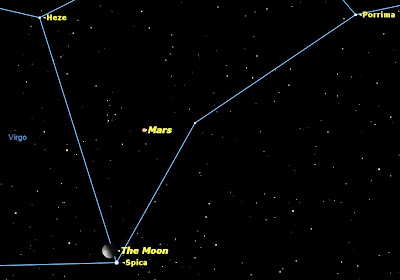Moon Phases
Wednesday, Jan. 1, 6:14 a.m. EST
New Moon
The Moon is not visible on the date of New Moon because it
is too close to the Sun, but can be seen low in the east as a narrow crescent a
morning or two before, just before sunrise. It is visible low in the west an
evening or two after New Moon. This is the first of two New Moons this month.
Tuesday, Jan. 7, 10:39 p.m. EST
First Quarter Moon
The First Quarter Moon rises around 11:20 a.m. and sets around
12:50 a.m. It dominates the evening sky.
Wednesday, Jan. 15, 11:52 p.m. EST
Full Moon
The Full Moon of January is known as the Wolf Moon or the Old
Moon. It rises around sunset and sets around sunrise, the only night in the
month when the Moon is in the sky all night long. The rest of the month, the
Moon spends at least some time in the daytime sky. This will be the smallest
full moon in 2014.
Friday, Jan. 24, 12:19 a.m. EST
Last Quarter Moon
The Last Quarter Moon rises around 1 a.m. and sets around 11:40
a.m. It is most easily seen just after sunrise in the southern sky.
Thursday, Jan. 30, 4:38 p.m. EST
New Moon
This is the second New Moon this month. There is no special
name for this event.
Observing Highlights
Thursday and Friday, Jan. 2 and 3, between midnight and dawn
Quadrantid meteor shower
The Quadrantid meteor shower peaks at 3 p.m. EST on January
2, during daylight. The best times to observe will be Thursday morning and
Friday morning, between midnight and dawn. The meteors appear to radiate from a
point between northern Bootes and the handle of the Big Dipper, once part of an
obsolete constellation called Quadrans Muralis, the Wall Quadrant.
Sunday, Jan. 5
Jupiter at opposition
Jupiter will be exactly opposite the Sun in Earth’s sky. It
rises in the east at sunset and sets in the west at sunrise, visible all night
long. Jupiter is currently in the far northern constellation of Gemini, so will
be high in the sky for northern observers, surrounded by five of the brightest
stars in the sky: Capella, Betelgeuse, Procyon, Pollux and Castor.
Saturday, Jan. 11
Venus at inferior conjunction
In its transition from “evening star” to “morning star,”
Venus passes between Earth and Sun today. Because of the tilt of its orbit, it
passes six degrees north of the Sun, rather than directly in front as it did in
June 2012.
Thursday, Jan. 23, 5 a.m. EST
The Moon close to Spica
The Moon will pass just north of the bright star Spica in
Virgo, with Mars close by.
Saturday, Jan. 25, early morning
The Moon close to Saturn
The Moon will pass just south of Saturn in Libra. The Moon
will occult Saturn for observers in French Polynesia, New Zealand, southern
South America, and Antarctica.
Tuesday, Jan. 28, sunrise
The Moon close to Venus
The slender crescent Moon will be just to the right of Venus.
Wednesday, Jan. 29, sunrise
The Moon close to Venus
On Wednesday morning, the Moon will be even closer to Venus,
just below it and to the left, but the Moon will be only one day away from New so
may be difficult to see.
Friday, Jan. 31, sunset
Mercury at greatest elongation east
Mercury will be well placed for observation just after
sunset for observers in the northern hemisphere. The 1-day-old Moon will be
nearby.
Planets
Mercury is well
placed in the evening sky for observers in the northern hemisphere for the last
week of January.
Venus passes just
above the Sun on January 11. It may be glimpsed in the western sky just after
sunset at the beginning of the month and in the eastern sky just before sunrise
at the end of the month.
Mars is continues to
brighten in Virgo in the morning sky.
Jupiter is in
opposition on January 5 and shines brightly all night all month. The Great Red
Spot is easier to see than in many recent years, showing a distinct orange
color.
Saturn is low in the
eastern sky just before sunrise, in the constellation Libra.
Uranus is visible
all evening, setting around 11 p.m. It is in Pisces all month long.
Neptune, in
Aquarius, is visible in the early evening and sets around 8 p.m.
Geoff Gaherty
Starry Night Software Support
All graphics © 2014 Starry Night Software




















Nice job, Geoff. One detail about the Quadrantids is that the peak time of the shower is generally listed as the afternoon of Jan. 3 (according to RASC Observers Handbook and Sky & Telescope Jan 2014), not Jan. 2 so there may be a typo here. The most interesting detail may be the very short duration of the shower and the best mornings to watch would be the mornings of Jan. 3 and 4.
ReplyDelete